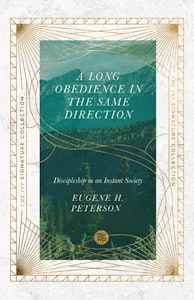 Excerpt from A Long Obedience in the Same Direction
Excerpt from A Long Obedience in the Same Direction
An old tradition sorts the difficulties we face in the life of faith into the categories of world, flesh and devil.1 We are, for the most part, well warned of the perils of the flesh and the wiles of the devil. Their temptations have a definable shape and maintain a historical continuity. That doesn’t make them any easier to resist; it does make them easier to recognize. The world, though, is protean: each generation has the world to deal with in a new form. World is an atmosphere, a mood.2 It is nearly as hard for a sinner to recognize the world’s temptations as it is for a fish to discover impurities in the water. There is a sense, a feeling, that things aren’t right, that the environment is not whole, but just what it is eludes analysis. We know that the spiritual atmosphere in which we live erodes faith, dissipates hope and corrupts love, but it is hard to put our finger on what is wrong.
Tourists and Pilgrims
One aspect of world that I have been able to identify as harmful to Christians is the assumption that anything worthwhile can be acquired at once. We assume that if something can be done at all, it can be done quickly and efficiently. Our attention spans have been conditioned by thirty-second commercials. Our sense of reality has been flattened by thirty-page abridgments.
It is not difficult in such a world to get a person interested in the message of the gospel; it is terrifically difficult to sustain the interest. Millions of people in our culture make decisions for Christ, but there is a dreadful attrition rate. Many claim to have been born again, but the evidence for mature Christian discipleship is slim. In our kind of culture anything, even news about God, can be sold if it is packaged freshly; but when it loses its novelty, it goes on the garbage heap. There is a great market for religious experience in our world; there is little enthusiasm for the patient acquisition of virtue, little inclination to sign up for a long apprenticeship in what earlier generations of Christians called holiness.
Religion in our time has been captured by the tourist mindset. Religion is understood as a visit to an attractive site to be made when we have adequate leisure. For some it is a weekly jaunt to church; for others, occasional visits to special services. Some, with a bent for religious entertainment and sacred diversion, plan their lives around special events like retreats, rallies and conferences. We go to see a new personality, to hear a new truth, to get a new experience and SO somehow expand our otherwise humdrum lives. The religious life is defined as the latest and the newest: Zen, faith healing, human potential, parapsychology, successful living, choreography in the chancel, Armageddon. We’ll try anything — until something else comes along.
I don’t know what it has been like for pastors in other cultures and previous centuries, but am quite sure that for a pastor in Western culture at the dawn of the twenty-first century, the aspect of world that makes the work of leading Christians in the way of faith most difficult is what Gore Vidal has analyzed as “today’s passion for the immediate and the casual.“3
Everyone is in a hurry. The persons whom I lead in worship, among whom I counsel, visit, pray, preach and teach, want shortcuts. They want me to help them fill out the form that will get them instant credit (in eternity). They are impatient for results. They have adopted the lifestyle of a tourist and only want the high points. But a pastor is not a tour guide. I have no interest in telling apocryphal religious stories at and around dubiously identified sacred sites. The Christian life cannot mature under such conditions and in such ways.
Friedrich Nietzsche, who saw this area of spiritual truth at least with great clarity, wrote, “The essential thing ‘in heaven and earth’ is that there should be long obedience in the same direction; there thereby results, and has always resulted in the long run, something which has made life worth living.“4 It is this “long obedience in the same direction” which the mood of the world does so much to discourage.
For recognizing and resisting the stream of the world’s ways there are two biblical designations for people of faith that are extremely useful: disciple and pilgrim. Disciple (mathetes) says we are people who spend our lives apprenticed to our master, Jesus Christ. We are in a growing-learning relationship, always. A disciple is a learner, but not in the academic setting of a school-room, rather at the work site of a craftsman. We do not acquire information about God but skills in faith.
Pilgrim (parepidemos) tells us we are people who spend our lives going someplace, going to God, and whose path for getting there is the way, Jesus Christ. We realize that “this world is not my home” and set out for “the Father’s house.” Abraham, who “went out,” is our archetype. Jesus, answering Thomas’s question “Master, we have no idea where you’re going. How do you expect us to know the road?” gives us directions: “I am the Road, also the Truth, also the Life. No one gets to the Father apart from me” (Jn 14:5 – 6).
The letter to the Hebrews defines our program: “Do you see what this means — all these pioneers who blazed the way, all these veterans cheering us on? It means we’d better get on with it. Strip down, start running and never quit! No extra spiritual fat, no parasitic sins. Keep your eyes on Jesus, who both began and finished this race we’re in” (Heb 12:1 – 2).
A Dog-Eared Songbook
In the pastoral work of training people in discipleship and accompanying them in pilgrimage, I have found, tucked away in the Hebrew Psalter, an old dog-eared songbook. I have used it to provide continuity in guiding others in the Christian way and directing people of faith in the conscious and continuous effort that develops into maturity in Christ.
The old songbook is called, in Hebrew, shiray hammaloth-Songs of Ascents. The songs are the psalms numbered 120 through 134 in the book of Psalms. These fifteen psalms were likely sung, possibly in sequence, by Hebrew pilgrims as they went up to Jerusalem to the great worship festivals. Topographically, Jerusalem was the highest city in Palestine, and so all who traveled there spent much of their time ascending.5 But the ascent was not only literal, it was also a metaphor: the trip to Jerusalem acted out a life lived upward toward God, an existence that advanced from one level to another in developing maturity-what Paul described as “the goal, where God is beckoning us onward to Jesus” (Phil 3:14).
Three times a year faithful Hebrews made that trip (Ex 23:14 – 17:-34:22 – 24). The Hebrews were a people whose salvation had been accomplished in the exodus, whose identity had been defined at Sinai and whose preservation had been assured in the forty years of wilderness wandering. As such a people, they regularly climbed the road to Jerusalem to worship. They refreshed their memories of God’s saving ways at the Feast of Passover in the spring; they renewed their commitments as God’s covenanted people at the Feast of Pentecost in early summer; they responded as a blessed community to the best that God had for them at the Feast of Tabernacles in the autumn. They were a redeemed people, a commanded people, a blessed people. These foundational realities were preached and taught and praised at the annual feasts. Between feasts the people lived these realities in daily discipleship until the time came to go up to the mountain city again as pilgrims to renew the covenant.
This picture of the Hebrews singing these fifteen psalms as they left their routines of discipleship and made their way from towns and villages, farms and cities, as pilgrims up to Jerusalem has become embedded in the Christian devotional imagination. It is our best background for understanding life as a faith-journey.
We know that our Lord from a very early age traveled to Jerusalem for the annual feasts (Lk 2:41 – 42). We continue to identify with the first disciples, who “set out for Jerusalem. Jesus had a head start on them, and they were following, puzzled and not just a little afraid” (Mk 10:32). We also are puzzled and a little afraid, for there is wonder upon unexpected wonder on this road, and there are fearful specters to be met. Singing the fifteen psalms is a way both to express the amazing grace and to quiet the anxious fears.
There are no better “songs for the road” for those who travel the way of faith in Christ, a way that has so many continuities with the way of Israel. Since many (not all) essential items in Christian discipleship are incorporated in these songs, they provide a way to remember who we are and where we are going. I have not sought to produce scholarly expositions of these psalms but to offer practical meditations that use these tunes for stimulus, encouragement and guidance. If we learn to sing them well, they can be a kind of vade mecum for a Christian’s daily walk.
For those who choose to live no longer as tourists but as pilgrims, the Songs of Ascents combine all the cheerfulness of a travel song with the practicality of a guidebook and map. Their unpretentious brevity is excellently described by William Faulkner. “They are not monuments, but footprints. A monument only says, ‘At least I got this far,’ while a footprint says, ‘This is where I was when I moved again.6
- The Book of Common Prayer (New York: Church Pension Fund, 1945), p. 276. ↩︎
- Amos T. Wilder writes, “World means more than ‘mankind fallen away from God.’ … The world is created and loved by God, and Christ has come to save it. But it is ephemeral, subject to decay and death; moreover, it has fallen under the control of the evil one, and therefore into darkness.” In The Interpreter’s Bible, ed. George Arthur But- trick (Nashville: Abingdon, 1952), 12:238. ↩︎
- Gore Vidal, Matters of Fact and Fiction (New York: Random House, 1977), p. 86. ↩︎
- Friedrich Nietzsche, Beyond Good and Evil, trans. Helen Zimmern (London: 1907), sec. 188. ↩︎
- There is no independent documentation that the Psalms of Ascents were used thus, and therefore no consensus among scholars that they were associated with the pilgrimage journeys to Jerusalem. The connection is conjectural but not at all fanciful. Commentators both Jewish and Christian have interpreted these psalms in this framework. ↩︎
- William Faulkner, quoted in Sam di Bonaventura’s program notes to Elie Siegmeister’s Symphony no. 5, Baltimore Symphony Concert, May 5, 1977. ↩︎
Taken from A Long Obedience in the Same Direction by Eugene H. Peterson. Copyright © 2000 by Eugene H. Peterson. Used by permission of InterVarsity Press. www.ivpress.com
Photo by Robert Bye on Unsplash
Text First Published June 1980 · Last Featured on Renovare.org August 2022


